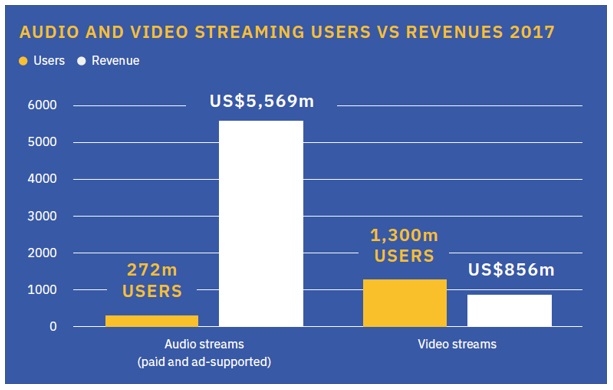Global Recorded Music Revenues Increase by 8.1%
Read the ‘State of the Industry’ report here
The global recorded music market grew by 8.1% in 2017, its third consecutive year of growth since IFPI began tracking the market in 1997. Figures released today in IFPI’s Global Music Report 2018 show total revenues for 2017 were US$17.3 billion.
Streaming remains the main driver of recovering revenues and, for the first time, has become the single largest revenue source with 176 million users of paid streaming services contributing to year-on-year streaming growth of 41.1%. Streaming now accounts for 38.4% of total recorded music revenue and its growth has more than offset a 5.4% decline in physical revenue and a 20.5% decline in download revenue. Total digital income last year accounted for more than half of all revenue (54%) for the first time.
The industry’s third consecutive year of growth follows 15 years of significant revenue decline. Despite the recent uplift, revenues for 2017 are still only 68.4% of the market’s peak in 1999.
Frances Moore, chief executive, IFPI, commented: “It’s been another incredibly exciting year for music. The work and investment from record companies is enabling brilliant, diverse artists to break through to fans around the world, soundtracking their lives and bringing them increasingly rich and immersive ways to enjoy the music they love.
“The industry is on a positive path of recovery but it’s very clear that the race is far from won.” Moore explained: “Record companies are continuing in their efforts to put the industry back onto a stable path and, to that end, we are continuing our campaign to fix the value gap. This is not just essential for music to thrive in today’s global market, but to create the right – fair – environment for it to do so in the future.”
Record companies are working to fuel this recent return to growth, driven by their ongoing investment, not only in artists but also in the digital innovations that are enriching the experience of music fans all over the world.
Beyond their efforts to nurture and break artists, record companies have also worked to foster growth in developing markets and have invested in the systems to deliver, manage and track the global distribution of music. Their partnerships are creating engaging ways for fans to access music on multiple services and platforms. This contributed to Latin American revenues growing by 17.7% and Asia and Australasia growing by 5.4%.
Record companies remain dedicated to ensuring full and fair value is returned for music as it is consumed in its many different forms around the world. Crucially, this involves finding a legislative solution to the value gap, the mismatch between the value created by some digital platforms from their use of music and what they pay to those creating and investing in it.
Key figures for 2017
About the value gap:

Inconsistent applications of online liability laws have emboldened certain digital platforms to claim that they are not liable for the music they make available to the public. Today, services such as YouTube, which have developed into sophisticated on-demand music platforms, use this as a shield to avoid licensing music like other digital services do, claiming they are not legally responsible for the music they distribute on their site.
Legislative action is needed to ensure that laws on copyright liability are applied correctly and consistently, so that platforms cannot claim they do not need to be licensed to distribute music. The music community is united in calling for policymakers to take action.
For more information and further explanation of the above value gap chart see pages 26 – 29 of the State of the Industry Report.
GMR: State of the Industry Report
The state of the industry report is available for free here (English language)
GMR: Full Report – with Data and Analysis
Purchase the full data and analysis report here
For further information please contact:
press@ifpi.org / +44 (0) 20 7878 7979
 @IFPI_ORG
@IFPI_ORG